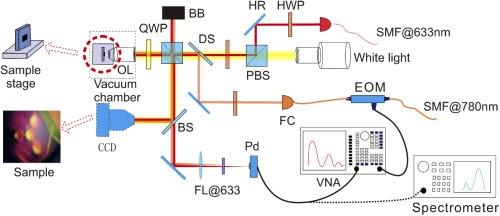Professor Konstantin Arutyunov of the HSE Tikhonov Moscow Institute of Electronics and Mathematics (MIEM HSE), together with Chinese researchers, has developed a graphene-based mechanical resonator, in which coherent emission of sound energy quanta, or phonons, has been induced. Such devices, called phonon lasers, have wide potential for application in information processing, as well as classical and quantum sensing of materials. The study is published in the journal Optics Express.
Using an analogy with photons, quanta of the electromagnetic spectrum, there are also particles of sound energy, phonons. In fact, these are artificially introduced objects in physics – quasi-particles, which correspond to vibrations of the crystal lattice of matter.
Some substances, when irradiated, emit photons of the same wavelength, phase, and polarisation. This process, called stimulated emission, was predicted by Albert Einstein over a century ago and is the basis of the device we all know – the laser. The first lasers were constructed about sixty years ago, and they have become firmly established in our lives in various fields.
A similar process, involving the emission of ‘identical’ phonons, underlies a device called, by analogy, a phonon laser, or saser. In fact, it was predicted at the same time as lasers, but only a few experimental realisations have been developed over a long period of time, and none of them have been widely used in the industry.
Magnesium ions, semiconductors, composite systems with microcavities, electromechanical resonators, nanoparticles, and many other substances and systems have been used as active media for phonon lasers over the last decade. Unlike previous studies, the present study used graphene to create coherent acoustic excitations. Due to the unique properties of graphene, such resonators can potentially be widely used.
The graphene resonator was produced by microlithography: a photo-sensitive polymer film is deposited on a silicon substrate. Using ultraviolet light, a certain structure is ‘drawn’ on the substrate, which subsequently allows the formation of a repeating system of micro-cavities by means of plasma treatment. The treated substrate is covered with a layer of graphene, and this system of ‘drums’ behaves like a resonator, i.e. it amplifies external vibrations if they are generated with a certain frequency.
If such a ‘drum’ is irradiated with laser light at a specific wavelength, photons are repeatedly reflected between the silicon backing and the graphene, thereby forming optical cavities where mechanical vibrations of the appropriate frequency are produced.
‘Experimentally, we have examined a nanostructure, which is a fixed membrane made of a monatomic layer of carbon, or a graphene. Vibrations of atoms, or phonons, were activated in it through exposure to external optical radiation,’ says Konstantin Arutyunov. ‘The research is expected to continue, as it is of considerable interest both for physics of ultra small objects and has the potential to create a new generation of quantum optomechanical sensors and transducers.’
###
Media Contact
Liudmila Mezentseva
[email protected]
Original Source
https:/
Related Journal Article
http://dx.





